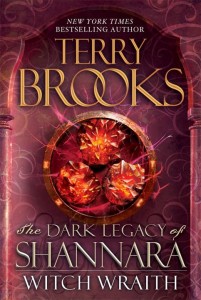
To begin this review of Witch Wraith I feel like I must dig into my past as not only a Terry Brooks fan, but also as a fan of Fantasy fiction, because the two are so inextricably intertwined that it is impossible to discuss one part of my fandom without crossing over into the other. It is not unusual for a Fantasy fan to cite Tolkien as the genesis of their fandom, as he certainly was for me, but it was ultimately Brooks, and then R.A. Salvatore, that cemented my love and created of it a lifelong obsession.
I first discovered Brooks after devouring The Hobbit and Lord of the Rings during my early adolescence. Eager, no, desperate for more Fantasy, I read any book my mom, the requisite Fantasy fan in my life, put in my hands. The most impressionable of these was Brooks’ The Sword of Shannara. It’s a novel that now, 35+ years after its first release, fights against its own beginnings as a Tolkien-inspired Fantasy that was crafted by its author and legendary editor Lester Del Rey to provide life and wind to the post-Tolkien doldrums that the genre fell into during the seventies. Where Stephen R. Donaldson, who published alongside Brooks, and was also edited by Lester Del Rey, chose to subvert Tolkien’s methods and themes, challenging the idea that Fantasy is myth and exploring its escapist nature — by casting a bitter adult, skeptical of the existence of the Fantasy world even as he walks through it — Brooks chose to emulate Tolkien by casting two plucky youths, a mysterious mentor, a world to save, and a keenness for adventure. Both stories feature a dark lord, but the their defeats come at the end of roads as different as those travelled by Samwise Gamgee and Meriadoc Brandybuck.
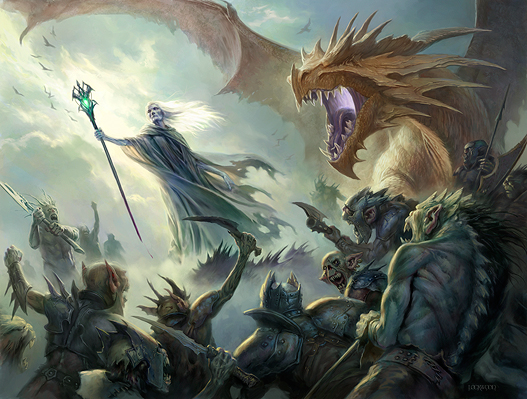
Art by Todd Lockwood
It is the conservativeness of his first novel that continues to define both his success as an author and his reputation among fans.
Del Rey attempted to boost the flagging Fantasy market in two ways: shock it with Donaldson, soothe it with Brooks. Donaldson has certainly had a long and successful career, and his impact on the genre is still felt today, but it’s Brooks who is most often credited for resurrecting the genre. He opened the door for a slew of post-Tolkien authors such as David Eddings, Tad Williams and Raymond E. Feist, who all continued to revitalize the idea that epic stories told in mythic lands still had an audience outside of Tolkien. The Sword of Shannara was, for all intents and purposes on the part of both Brooks (a fan) and Del Rey (an astute businessman) a prototypical clone of Lord of the Rings, embracing its structure, pacing, technology level and character archetypes. Brooks proceeded to write many wonderful and inventive novels, including his follow-up to The Sword of Shannara, The Elfstones of Shannara, and the Word & Void series, an Urban Fantasy precursor to the Shannara series. But, it is the conservativeness of his first novel that continues to define both his success as an author and his reputation among fantasy readers. Brooks is seen by a large portion of fans (many of whom, I’d guess, haven’t read past The Sword of Shannara,) as an author without a hint of originality to his writing. I’ve disagreed with for years. He was the beating heart at the centre of my Fantasy fandom and his novels filled my middle years with so much adventure, love, heartbreak, tragedy and heroism. But, slowly, since the turn of this century, I began to find myself wondering if those critics weren’t, in the smallest way, right about Brooks.
That’s not to take anything away from the novels he produced in the ’70s, ’80s and ’90s, there are still wonderful Fantasy novels there, but rather a criticism of his post-Ilse Witch work. His early novels certainly featured many familiar elements that perpetuated across each book — Ohmsfords, elfstones, hunters, trackers, mysterious magic — but, by virtue of his world still being young and Brooks still laying out the ground rules, peeling back mysteries, these elements did not detract from the overall tale. This was structure and repetition by design, familiar elements and themes stretched over several volumes and self-contained stories, often in the form of recurring characters or the children of previous heroes. Instead of rewriting the rules every time, the novels played out like a chess game. Same pieces, different moves. Chess, however, is timeless, and Brooks’ tropes and pieces, with every ‘game,’ began to grow a little… stale.
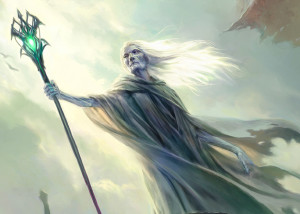
Art by Todd Lockwood
The first time I can remember noticing this was the release of Morgawr, the final volume in the Voyage of the Jerle Shannara series. It’s this disappointment, that continued to echo (and then amplify) in each of subsequent novels, that, will, ultimately, bring us to the reason why I think that Witch Wraith and The Dark Legacy of Shannara series are such a success. Setting aside The Genesis of Shannara and The Legends of Shannara series, which step far back in time and make a mess of the subtle ties between Brooks’ Fantasy and Urban Fantasy series, Brooks’ two trilogies following The Heritage of Shannara series, considered by many fans to be his best work, follow the same flawed structure: great opening novel, rushed middle book, flat ending that leaves more questions than answers. I was expecting Morgawr to end with the same sort of world-shattering consequence as Brooks’ previous books/series, but was instead left with something that felt hollow and incomplete. The experience was repeated again with Straken, the final book of The Dark Legacy of Shannara. By that point, I was afraid that, despite my every effort to fight it, I was beginning to admit that maybe, just maybe, Brooks had lost it.
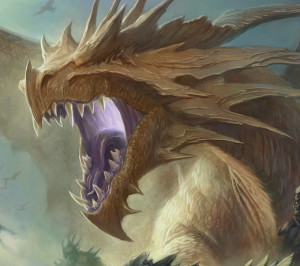
Art by Todd Lockwood
Witch Wraith, in retrospect, is the culmination of the events that first began in Ilse Witch. A main criticism of The Voyage of the Jerle Shannara, The High Druid of Shannara and The Dark Legacy of Shannara is that, despite being marketed and released as such, they aren’t trilogies in the traditional sense, but Lord of the Rings-style one-book-in-three-volumes. The first volume of each covers the opening act, the middle volume is the second act, and the third volume is the climactic third act. It’s better to consider the ‘trilogy’ to be the story told across all nine of the books, beginning with Ilse Witch and ending with Witch Wraith. Let’s call this the Ilse Witch Trilogy, for lack of an official name. In fact, I cannot recommend beginning Ilse Witch without the reader understanding that they won’t find a conclusion to the story for another eight volumes. Each trilogy, in this case, acts as its own ‘volume’ in the overarching story. Now that they’re all released, it’s gravy. But, spending 13 years reading this ‘trilogy,’ without understanding its true nature, was an exercise in frustration for fans hoping for any sort of resolution.
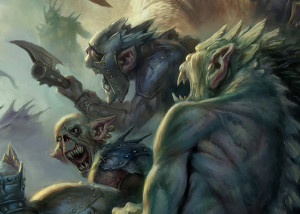
Art by Todd Lockwood
Witch Wraith feels like a culmination of everything Brooks has been writing since The Elfstones of Shannara.
That all said, it’s with no small amount of surprise that I have nothing but praise to heap upon Witch Wraith, as a conclusion to The Dark Legacy of Shannara and the Ilse Witch Trilogy, is as satisfying and grandiose as anything Brooks has written. Does it recycle the ending to The Elfstones of Shannara? Absolutely. In fact, it’s almost exactly the same (uhh… spoiler warning?), but it’s not any less emotionally affecting (with some of Brooks’ best characters) or raucously adventurous s his previous works. If you’ve read Brooks before, it won’t blow you away, but, in many ways, Witch Wraith feels like a culmination of everything Brooks has been writing since The Elfstones of Shannara, an attempt to wrangle together a sprawling story and inject with with the impact of his early stand alone novels. Just by existing, Witch Wraith and The Dark Legacy of Shannara change the nature of the first two volumes of The Ilse Witch trilogy and take them from being footnotes in Brooks’ career to a cornerstone.
This doesn’t excuse some of the flaws in the earlier novels (particularly the weak writing and plotting of Tanequil), but when considered as a whole, the Ilse Witch Trilogy, has explores strong thematic elements of family, sacrifice and a fast changing world outpacing its history and forgetting its mistakes. Witch Wraith makes the books before it stronger by giving weight to the decisions, sacrifices and conflicts that at first seemed pointless. Hollow. What did Grianne change by making the decision she did at the end of Straken? What did the voyage in The Voyage of the Jerle Shannara mean for the world at large? We get our answers in Witch Wraith and the pieces have been falling into place since the final pages of The Elfstones of Shannara.
At the heart of this set of novels is Grianne Ohmsford. She’s powerful, tortured and, over the course of nine novels, follows a circular arc of character growth that is the pinnacle of Brooks’ storytelling. We are introduced to her as the Ilse Witch, her mind rotted by the magic and lies of her master, we see her break free of those shackles, struggle with her past sins, try to right the world, and, ultimately, we watch her crumble under the weight of her demons. The ending of Witch Wraith is bitter-sweet, but Brooks’ none-too-kind treatment of Grianne is a refreshing and somewhat shocking turn for the Shannara series. Her decisions, her struggles, conflicts, flaws and strengths are the beating heart of Brooks’ work. There’s genuine sadness in her story and she’s well deserving of this nine-volume arc. So, bravo there.
Witch Wraith is a suitably climactic conclusion, with enough twists, turns and mayhem to please any fan.
The Dark Legacy of Shannara is the finest Shannara series Brooks has written since The Heritage of Shannara, twenty years ago, and Witch Wraith is a suitably climactic conclusion, with enough twists, turns and mayhem to please any fan. While it won’t turn skeptics to believers, fans of the Shannara series have a lot to look forward to. Most importantly, the revelations and conclusions to long-running storylines are satisfying and give strength to some of Brooks’ earlier works just by virtue of existing. For the first time in a long time, I feel the urge to travel back to the middle period in Brooks’ career, starting with Ilse Witch to rediscover some of his works that I have long since shrugged off. This Terry Brooks fan is breathing easy. Brooks hasn’t lost it, after all. He just misplaced it for a while.

As I said on twitter, each review you’ve published for the three books in this series is encouraging me to pull the books off of Mount Toberead and read them. Been in the mood for this type of Epic Fantasy and these books look like they could fit the bill. The physical books themselves look great, too. I like the packaging and the Lockwood art inserts.
i have been reading Shannara since 1992. all of his books are amazing. i dont read much fantasy that compares with his work. i really feel that he closed a bunch of doors in witch wraith, concluding questions readers have had for 25 years. he also opened alot of new doors and possibilities on where hell be taking the 4 lands in the future. i cant wait for the stand alone book due to release in march (?)
The main thing I disagree with is Grianne. Had we seen her struggle with her demons and ultimately collapse under them, reverting back to the Isle Witch, I would have been okay with where her character arc ended. But we didn’t. Grianne was simply given back to the world as the Isle Witch by the Tanequil because….apparently magic trees have the ability to hit the reset button on character development…I guess. I thought that was poor writing, and very disappointing. I felt Terry short ended a character that he had developed beautifully over his previous novels, and I felt cheated by how he handled her.
But… Chris K, Grianne’s story is not finished, yet… =)